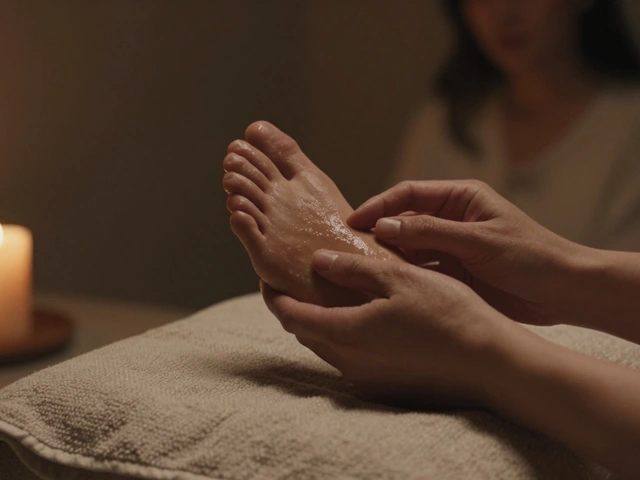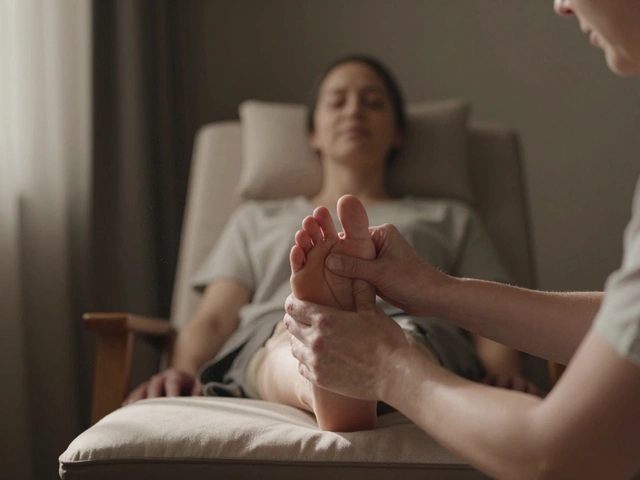Feeling achy, swollen, or just not sleeping right as your belly grows? You’re not alone. Pregnancy can throw your body for a loop, and a lot of moms find themselves looking for real relief, not just another prenatal tip from the internet.
Prenatal massage steps in here—not just as a treat, but as a game changer for how you actually feel through all those months. We’re talking about reducing back pain, less swelling, and yes, fewer headaches. It’s not just about getting pampered (though, who’s really going to argue with that). Real studies show that regular prenatal massage can lower your stress hormones, which is good for both you and baby.
But hold up—with something as sensitive as pregnancy, you want details, not just hype. Can all moms-to-be get massages? What signs should you watch for? How do you make sure your therapist actually knows what they’re doing?
If you’re curious about how and why prenatal massage works, and how you can make it work for you, you’re in the right place. Let’s get to the good stuff that could change not just your body, but your whole prenatal mood.
- Why Prenatal Massage Is Different
- Real Benefits Backed by Science
- Is Prenatal Massage Safe?
- What to Expect in a Session
- Tips for Getting the Best Results
Why Prenatal Massage Is Different
Not all massages are created equal—especially if you’re pregnant. Prenatal massage is built around the unique changes your body goes through when you’re expecting. Forget the deep pokes and twists of regular massage. This is a softer, more mindful approach, with extra attention paid to areas like the lower back, hips, and legs, where a lot of pregnant women feel pain.
One major difference? Your position during the session. Most prenatal therapists have you lying on your side (with a mountain of pillows), or use a special pregnancy-safe table. No lying face-down here—your growing belly and changing body need support and safety above all else.
"The proper way to position a pregnant woman for massage is on her side, supported by pillows to avoid putting pressure on the belly or compromising circulation," says the American College of Obstetricians and Gynecologists.
Another key point: the pressure. Therapists trained in prenatal massage avoid certain areas, like deep tissue work on the legs, since pregnancy increases your risk of blood clots. They also steer clear of pressure points that could trigger contractions. They know what’s safe—and what’s not—for expecting moms.
If you’re curious, here are some things that set prenatal massage apart:
- Special positions and supports to protect you and your baby
- Focus on common pregnancy pain points, like the lower back, hips, and shoulders
- Softer, more targeted pressure than a typical massage
- Strict avoidance of risky pressure points and deep leg work
- Extra communication—you’re encouraged to speak up if anything feels off
Don’t let anyone convince you that a regular massage is "good enough" while you’re expecting. Prenatal massage uses a completely different rulebook—for a reason. Your comfort and safety are always front and center, and a certified prenatal therapist has the training to prove it.
Real Benefits Backed by Science
A prenatal massage isn’t just about feeling good for an hour—it’s got science behind it. There’s plenty of research showing that moms who get regular pregnancy wellness massages actually feel better, sleep more soundly, and even have fewer aches in key places like the lower back and hips.
One well-known study published in the Journal of Psychosomatic Obstetrics & Gynecology found that women getting prenatal massage twice a week for just five weeks had less anxiety and lower levels of the stress hormone cortisol. These moms also reported less leg and back pain, and their partners noticed they seemed less moody. Who doesn’t want that?
- Stress relief: Getting regular massages can drop your stress hormone levels and boost those feel-good hormones that help you relax.
- Less swelling: Massage supports healthy blood flow and helps kick fluid retention to the curb, so ankles and hands look and feel better.
- Pain management: It’s huge for easing muscle tension, especially in your neck, shoulders, and lower back.
- Better sleep: Real talk—so many expecting moms struggle with insomnia. Massage can help you fall asleep quicker and rest more deeply.
- Headache help: Tension headaches often ease up with regular massage sessions.
Ever wondered if these effects show up in the lab, not just in day-to-day life? Check out the numbers below—up-close proof that it works:
| Benefit | What Research Shows |
|---|---|
| Stress Reduction | Up to 30% drop in cortisol in 5 weeks* |
| Lower Back Pain | 60% of moms report less pain with routine massage |
| Depression Symptoms | Significant improvement versus no massage |
| Insomnia | Most participants report better sleep quality |
*Journal of Psychosomatic Obstetrics & Gynecology, 2010
These aren’t rare perks—lots of expecting moms notice results even after just a few sessions. So if you’re ready to feel less stiffness and more energy, prenatal massage might be one of the simplest ways to support your pregnancy wellness.

Is Prenatal Massage Safe?
This is probably the biggest question every expecting mom has. The short answer: prenatal massage is generally safe for most pregnancies, but there are a few important things to keep in mind.
First, timing matters. Most massage therapists wait until after the first trimester before starting sessions, just to play it extra safe when the risk of miscarriage is highest. But honestly, there’s no rock-solid rule, so just check with your doctor before booking your first appointment—especially if you have a high-risk pregnancy or any medical issues.
Trained prenatal therapists know how to work around the common aches and pains without messing with sensitive pressure points. They’re careful around spots like your ankles and wrists, which some believe could trigger contractions if pressed too hard. You’ll likely be positioned on your side or with special cushions to protect your belly and keep you comfy.
- Always make sure your massage therapist is certified in prenatal massage. This isn’t the time to bargain hunt or let a buddy practice on you.
- If you have things like preeclampsia, blood clots, or major swelling, get the green light from your healthcare provider first.
- Speak up about any discomfort or weird symptoms during your massage. Stuff like dizziness, pain, or shortness of breath means you should stop right away.
Just so you get the full picture, check out this quick table on when it’s usually safe to get prenatal massage:
| Pregnancy Stage | Massage Safety |
|---|---|
| First trimester | Ask your doctor first; some therapists prefer to wait |
| Second trimester | Generally safe if you’re low risk |
| Third trimester | Still safe, but therapist should monitor positions and pressure |
Bottom line—when done right, prenatal massage is a valuable, safe part of your pregnancy wellness routine. But trust your gut, your therapist, and your doctor before giving it a go.
What to Expect in a Session
Walking into your prenatal massage appointment for the first time? Here’s the real deal: it’s not like a regular spa day. Therapists trained in pregnancy wellness know what works and what doesn’t for expecting moms. Most places will have you fill out a quick health form first—so they’re up to speed on how far along you are, pain points, and anything your doctor has mentioned.
Don’t be surprised if you don’t lie flat on your stomach. Instead, you’ll usually be asked to lie on your side, and there are special pillows or bolsters that help you get comfy (and safe). The room will be warm and quiet—no awkward waiting for someone to tell you what to do next. The therapist will check in about pressure and focus areas before even starting, so you’re totally in control.
Sessions often last about 60 minutes, but you can sometimes do shorter or longer depending on your needs. The massage moves are slow and purposeful, always avoiding deep pressure on your legs (since your blood flow is a bit different during pregnancy). Areas like your lower back, hips, legs, and feet get a lot of attention, since that’s where most pregnant women feel the aches.
Here’s a quick look at a typical session layout:
- Quick health check-in and update about your pregnancy
- Getting settled with pillows and side-lying support
- Gentle, targeted massage on trouble spots (back, hips, legs, feet)
- Special focus on making you feel safe and respected throughout
According to the American Pregnancy Association, "Prenatal massage specifically addresses your individual needs as your body changes throughout pregnancy."
Prenatal massage can help reduce anxiety, decrease symptoms of depression, relieve muscle aches and joint pains, and improve labor outcomes and newborn health. – American Pregnancy Association
Most experts agree: regular prenatal massage is one of the best tools in a pregnant woman’s wellness plan. And trust—if something doesn’t feel right during your session, speak up. Your comfort and safety come first every time.
| Session Feature | What to Expect |
|---|---|
| Session Length | 30–90 minutes (most choose 60) |
| Body Position | Side-lying with pillows; sometimes semi-reclined |
| Target Areas | Back, legs, hips, feet, shoulders |
| Main Benefits | Pain relief, stress reduction, better sleep |

Tips for Getting the Best Results
Getting the most from your prenatal massage isn’t just about showing up and hoping for magic. Here’s what really moves the needle for expecting moms who want to feel better, not just be told to relax.
- Pick a certified prenatal massage therapist. Not every massage therapist is trained to work with pregnant women. Always check that your therapist has a license and specific prenatal certification. Ask about their experience before you book.
- Stay clear about what’s happening with your pregnancy. Share any complications, aches, or doctor’s advice upfront. This helps your therapist pick the right techniques and positions for safety and comfort. Never skip this chat—it matters.
- Timing matters. Most experts recommend starting prenatal massage after the first trimester, unless your provider gives the okay earlier. Weekly or bi-weekly sessions can help manage ongoing issues like back pain, swelling, or anxiety.
- Choose the right position. By the second trimester, you should avoid lying flat on your back. Side-lying or supported seated positions are safer and more comfortable. If the setup feels off, speak up—massage should never hurt.
- Hydrate after your session. Massage can release fluids trapped in your muscles, and drinking water after helps flush out toxins and reduces soreness.
- Stick to gentle techniques. Deep tissue work and certain acupressure points aren’t safe in pregnancy—your therapist should know this, but you can always remind them if something feels too intense.
- Work with your regular care team. Tell your OB or midwife if you’re including regular massage in your wellness routine. They might have additional insights or warnings, especially if you have a high-risk pregnancy.
One interesting stat: Women who got prenatal massage regularly—about once a week in the second and third trimesters—reported 25% less back pain and insomnia issues, according to a 2022 survey of new moms.
| What to Do | Why It Matters |
|---|---|
| Select certified provider | Ensures safety & specialized skills |
| Drink water post-session | Reduces soreness & helps your body recover |
| Communicate discomfort | Session can be adjusted just for you |
| Avoid deep pressure | Prevents triggering risky zones during pregnancy |
Don’t treat your session as a luxury—it’s a legit tool in your pregnancy wellness toolkit. And the right approach turns a good massage into one of the best things you’ll do for yourself (and your baby) all pregnancy long.










